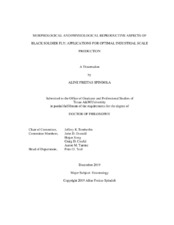| dc.description.abstract | The successful commercialization of the black soldier fly, Hermetia illucens (L.), relies on the maintenance of fecund adults. Current mass-rearing protocols has resulted in variable production of fertile eggs. The root cause for this variation relies on the lack of understanding of parameters related to their morphology, physiology, and behavior. This study was the first to describe the BSF male reproductive tract and spermatozoa, associated spermatogenesis process, the female spermatheca morphology, and the impact of age on the production of sperm, its viability and how those flies adjust thermal preferences to reach reproductive success. Using three different microscopy techniques, it was shown the gross morphology of the male reproductive tract and female spermatheca appear to be similar to those found in other brachyceran flies.
Male spermatozoa are long (∼860 µm overall, ~8 µm head), apparently motile, and possess flagella with a typical 9+9+2 axoneme triplet. Germ cells go through incomplete mitotic divisions surrounded by somatic cyst cells in the testes. Spermatogenesis appears to be initiated during immature development (cryptocephalic pupa stage). From <24 h to 7 d post emergence, male aging appeared to impact sperm production. Analyzing the reproductive capacity of males through aging, age significantly impacted sperm number, which peaked (322.5(214.5-429.3)) when the adults were approximately 48-hold and then gradually declined. Sperm viability remained consistent as the adults aged (69.7% (60.5%-76.7%). The thermal preference (Tsel) for <24-h old male (24.3℃ (19.3℃- 28.2℃)) and BSF female (20.2℃ (15.4℃-26.2℃)) were significantly different. These temperatures gradually declined over time and then increased to levels close to those initially preferred. Temperatures (20℃, 24℃, and 27℃) examined for their impact on sperm number and viability did not produce significant results. Future studies should explore a wide range of temperatures as well other physiological conditions that might impact thermal preference (i.e. starvation). Morphological data may provide clues on why females of this specie display a monogamous, rather than the polyandrous mating system, and how adults from this specie allocate resources for optimal fitness. | en |


